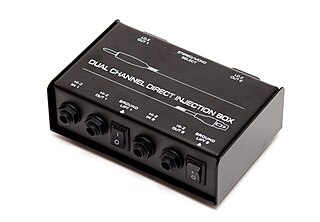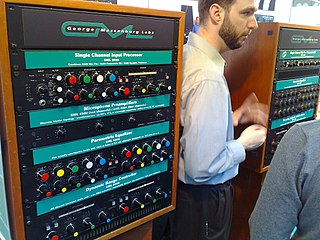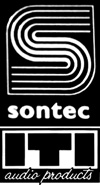
A mixing console or mixing desk is an electronic device for mixing audio signals, used in sound recording and reproduction and sound reinforcement systems. Inputs to the console include microphones, signals from electric or electronic instruments, or recorded sounds. Mixers may control analog or digital signals. The modified signals are summed to produce the combined output signals, which can then be broadcast, amplified through a sound reinforcement system or recorded.

A recording studio is a specialized facility for sound recording, mixing, and audio production of instrumental or vocal musical performances, spoken words, and other sounds. They range in size from a small in-home project studio large enough to record a single singer-guitarist, to a large building with space for a full orchestra of 100 or more musicians. Ideally, both the recording and monitoring spaces are specially designed by an acoustician or audio engineer to achieve optimum acoustic properties.

Mastering, a form of audio post production, is the process of preparing and transferring recorded audio from a source containing the final mix to a data storage device, the source from which all copies will be produced. In recent years digital masters have become usual, although analog masters—such as audio tapes—are still being used by the manufacturing industry, particularly by a few engineers who specialize in analog mastering.

A DI unit is an electronic device typically used in recording studios and in sound reinforcement systems to connect a high-output impedance, line level, unbalanced output signal to a low-impedance, microphone level, balanced input, usually via an XLR connector and XLR cable. DIs are frequently used to connect an electric guitar or electric bass to a mixing console's microphone input jack. The DI performs level matching, balancing, and either active buffering or passive impedance matching/impedance bridging to minimize unwanted noise, distortion, and ground loops. DI units are typically metal boxes with input and output jacks and, for more expensive units, “ground lift” and attenuator switches.
Remaster refers to changing the quality of the sound or of the image, or both, of previously created recordings, either audiophonic, cinematic, or videographic. The terms digital remastering and digitally remastered are also used.
Solid State Logic (SSL) is a British company based in Begbroke, Oxfordshire, England that designs and markets audio mixing consoles, signal processors, and other audio technologies for the post-production, video production, broadcast, sound reinforcement and music recording industries. SSL employs over 160 people worldwide and has regional offices in Los Angeles, Milan, New York, Paris, and Tokyo, with additional support provided by an international network of distributors. Solid State Logic is part of the Audiotonix Group.

Mobile Fidelity Sound Lab is a record label specializing in the production of audiophile issues. The company is best known for its reissued vinyl LP records, compact discs, and Super Audio CDs but has also produced other formats.
A variable-gain (VGA) or voltage-controlled amplifier (VCA) is an electronic amplifier that varies its gain depending on a control voltage.
Daniel N. Flickinger was an audio engineer in the late 1960s and 1970s, who designed and manufactured some of the era's most important music recording consoles. He designed recording consoles for Sly Stone, Curtis Mayfield, The Association, Ike Turner's Bolic Sound, Johnny Cash, and Funkadelic, Muscle Shoals Sound Studio, Motown Records, Cinderella Records, and United Sound Systems among many others.

George Y. Massenburg is a recording engineer and inventor. Working principally in Baltimore, Los Angeles, Nashville, and Macon, Georgia, Massenburg is widely known for submitting a paper to the Audio Engineering Society in 1972 regarding the parametric equalizer.
Automated Processes Inc. (API) is an American company that designs, manufactures, and markets mixing consoles and signal processors, including modular signal processor units in the 500-series format standard that evolved from early API mixing consoles.
Re-amping is a process often used in multitrack recording in which a recorded signal is routed back out of the editing environment and run through external processing using effects units and then into a guitar amplifier and a guitar speaker cabinet or a reverb chamber. Originally, the technique was used mostly for electric guitars: it facilitates a separation of guitar playing from guitar amplifier processing—a previously recorded audio program is played back and re-recorded at a later time for the purpose of adding effects, ambiance such as reverb or echo, and the tone shaping imbued by certain amps and cabinets. The technique has since evolved over the 2000s to include many other applications. Re-amping can also be applied to other instruments and program, such as recorded drums, synthesizers, and virtual instruments.
Arthur Rupert Neve was a British-American electronics engineer and entrepreneur, who was a pioneering designer of professional audio recording equipment. He designed analog recording and audio mixing equipment that was sought after by professional musicians and recording technicians. Some of his customers were music groups The Beatles, Aerosmith and Nirvana, and recording studios Sound City Studios and Abbey Road Studios. Companies that he was associated with included Neve Electronics, Focusrite, AMS Neve, and Rupert Neve Designs.

Capitol Studios are recording studios located at the landmark Capitol Records Tower in Hollywood, California. Established in 1956, the studios were initially the primary recording studios for American record label Capitol Records. While they are still regularly used by Capitol recording artists, the studios began making the facility available to artists outside the label during the late 1960s to early 1970s. The studios are owned by Universal Music Group, the parent company of Capitol Music Group.

Direct metal mastering (DMM) is an analog audio disc mastering technique jointly developed by two German companies, Telefunken-Decca (Teldec) and Georg Neumann GmbH, toward the end of the 20th century after having seen the same technology used by RCA Princeton Labs for its SelectaVision videodiscs in the late-1970s.

An audio engineer helps to produce a recording or a live performance, balancing and adjusting sound sources using equalization, dynamics processing and audio effects, mixing, reproduction, and reinforcement of sound. Audio engineers work on the "technical aspect of recording—the placing of microphones, pre-amp knobs, the setting of levels. The physical recording of any project is done by an engineer... the nuts and bolts."

Metropolis Studios is a music production and entertainment industry company established in 1989 by Gary Langan, Carey Taylor and Karin Clayton. It is located in the Powerhouse, a Grade II listed building, at 70 Chiswick High Road in Chiswick, London, England. Over the last twenty years the group has expanded and now consists of three divisions: Metropolis Studios, Metropolis Mastering, and Digital Media/Productions.
A mixing engineer is responsible for combining ("mixing") different sonic elements of an auditory piece into a complete rendition, whether in music, film, or any other content of auditory nature. The finished piece, recorded or live, must achieve a good balance of properties, such as volume, pan positioning, and other effects, while resolving any arising frequency conflicts from various sound sources. These sound sources can comprise the different musical instruments or vocals in a band or orchestra, dialogue or foley in a film, and more.

Equalization in sound recording and reproduction is the process of adjusting the volume of different frequency bands within an audio signal. The circuit or equipment used to achieve this is called an equalizer.
The Solid State Logic SL 4000 is a series of large-format analogue mixing consoles designed and manufactured by Solid State Logic (SSL) from 1976 to 2002. 4000 Series consoles were widely adopted by major commercial recording studios in the 1980s.











